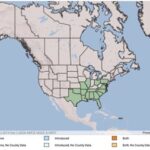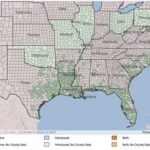Dichondra carolinensis
Illustration: USDA-NRCS PLANTS Database / Britton, N.L., and A. Brown. 1913. An illustrated flora of the northern United States, Canada and the British Possessions. 3 vols. Charles Scribner’s Sons, New York. Vol. 3: 40.
What is Carolina Pony’s Foot?
Physical Characteristics
- Forming mats
Leaves:
- Long leaf stalks
- Oval or egg shaped
Flowers:
Fruit:
- 2-4 seeded
Stem:
- Rooting at nodes
- 0.39-4.72 inches tall
Where Does it Grow?
USDA, NRCS. 2018. The PLANTS Database (http://plants.usda.gov). National Plant Data Team, Greensboro, NC 27401-4901 USA.
Carolina pony’s foot can be found in deep, open ground, in mud along the edge of lakes and ponds, on the edges of swamps and marshes, and along roadsides and lawns.
Pros and Cons of Carolina Pony’s Foot
Submerged portions of all aquatic plants provide habitats for many micro and macro invertebrates. These invertebrates in turn are used as food by fish and other wildlife species (e.g. amphibians, reptiles, ducks, etc.). After aquatic plants die, their decomposition by bacteria and fungi provides food (called “detritus”) for many aquatic invertebrates.




